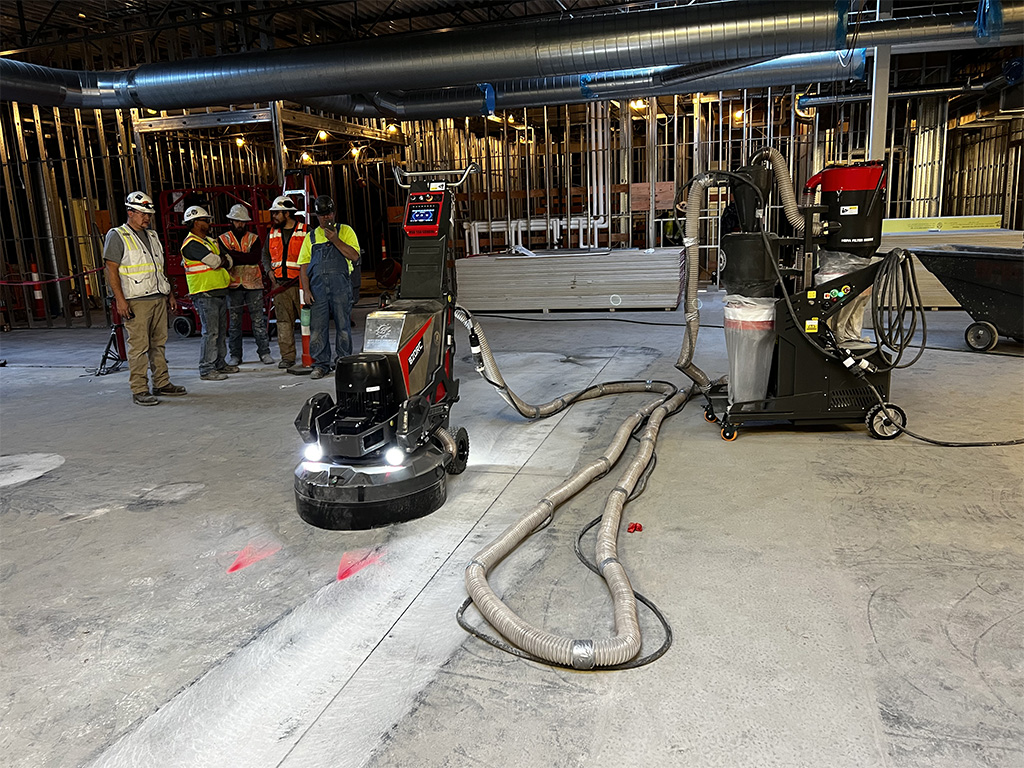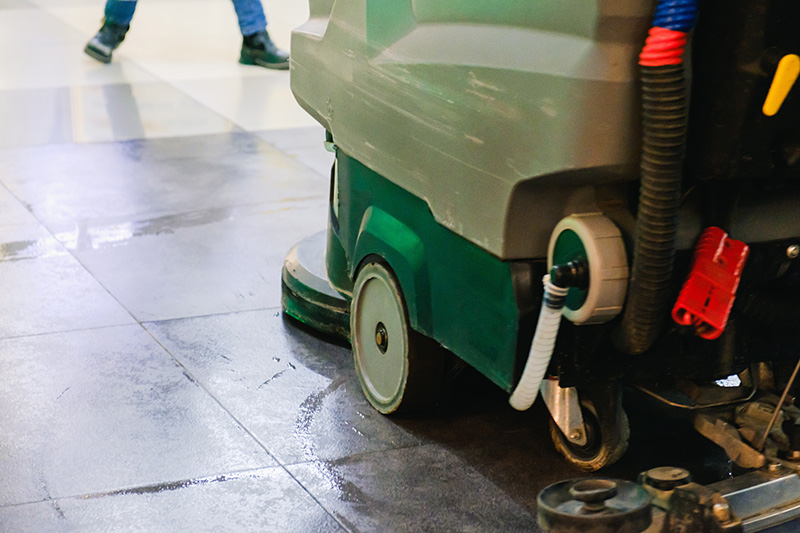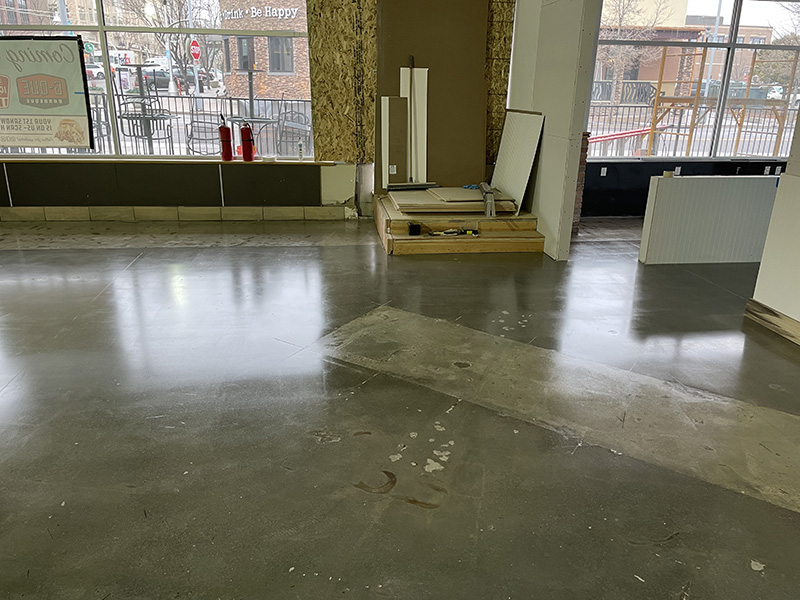Sealed Concrete vs. Polished Concrete
Over the last couple of years, both sealed concrete and polished concrete have significantly grown in popularity. Whereas these used to be “industrial” flooring choices, the industrial look has become popular in retail, restaurants, other businesses and even homes.
Exploring the right choice for your application of polished vs. sealed concrete floors starts with understanding the differences between the processes, as well as the expected results.
We’ll explore three primary options in the order of their complexity as well as cost
- Clean and seal concrete floors
- Grind and seal concrete floors
- Polished concrete floors
Before we get into the specifics of each method, let’s look at a comparison between sealed and polished concrete as well as pros and cons of each method.
Sealed Concrete Vs Polished Concrete
There are significant differences in grind and seal vs. polished concrete floors.
Grind and Seal
A grind and sealed floor (or simply a clean and sealed floor) is simply getting the concrete prepared adequately to then apply a sealer to the floor.
The shine and reflectivity ultimately comes from the applied sealer, not from the floor being highly polished.
Polished Concrete
Meanwhile, with a polished concrete floor, the shine and reflectivity comes from densifying the floor and then mechanically grinding it with finer and finer diamonds until the floor itself is reflective without requiring a sealer.
Sealed polished concrete is not necessary as through the densifying, polishing and burnishing process, we achieve a similar result as to applying a sealer to the floor.
Both options can look good. However, polished vs sealed concrete floors isn’t a fair comparison. A polished concrete floor will look better. It also won’t wear through the sealer over time. This means less maintenance and lower costs in the long run.

Polishing floors on a 9,500 sq. ft. industrial project with our remote controlled dustless grinder and vacuum.
Sealed Concrete
Sealed Concrete Pros
-
- Lower initial cost – The prep work is far less labor intensive than polished concrete.
- Great initial appearance compared against price
- Variety of sealers available to change appearance (flat, matte, gloss)
- Sealed surface can work well with spills and custom sealers are available for certain environments
Sealed Concrete Cons
-
- Can’t achieve the same level of polish and quality appearance of polished concrete
- Sealer eventually wears off, especially in high traffic areas, and requires cleaning and re-coating
Polished Concrete
Polished Concrete Pros
-
- Low maintenance
- Does not require re-coating due to damage or wear
- Great scratch resisant appearance
- Can be brought to a much higher and clearer reflective gloss than sealed concrete
Polished Concrete Cons
-
- Higher initial cost to polish vs. seal concrete
- Not necessarily sealed as well as certain concrete sealers, especially for specific applications like gas, oil, certain chemicals

Clean and Seal Concrete Floors
Cleaning and sealing concrete floors is the easiest way to achieve the architectural industrial concrete floor look that many people are after.
Clean and Seal Concrete Process
The clean and seal concrete process involves mechanically cleaning the concrete floor. This usually is done with an autoscrubber. Alternately, a floor buffer equipped with a white pad can work as well.
The concrete is cleaned, removing dirt, grime, or other contaminants. An autoscrubber applies water and cleaning solution, then scrubs the floor, and finally it extracts the waste water.
Next, an appropriate sealer will be applied to the floor to achieve the desired look and performance of the interior floor.
A flat, matte or glossy concrete floor sealer all exist. Different sealers can be applied in either one or two coats to achieve the necessary sheen.
Limitations
There are some limitations where a clean and seal is not going to make sense. First, the quality and condition of the existing concrete slab must be suitable. Concrete that is damaged, spider cracked, or uneven, will require additional work done to it before it can be eligible for a clean and seal.
Grind and Seal Concrete Floors
Grinding and sealing concrete is done by first using a diamond floor grinder attached to a HEPA vacuum and dust collector. The concrete slab is ground in successive steps to reveal a smooth surface. Depending on the initial condition of the concrete, an appropriately matched diamond grit is selected.
Grind and Seal Process
If the floor is rough, we need to start with a very aggressive grit with the intention or removing material from the floor. After we achieve a level, prepared surface, we then grind with progressively finer, less aggressive diamonds until we have removed scratches and have a uniform appearance.
The higher up the scale we can start, the fewer passes we need to make and thus the lower cost of the work.
As we are grinding the floor, we can also stay at low grit diamonds for more passes to expose increasingly more aggregate as we get deeper into the slab. Sometimes customers like to see more aggregate in the floor before it is sealed.
Once the grinding is completed, the floor is cleaned and sealed in the same process as the “Clean and seal concrete” above.

Low grit concrete polish in a restaurant.
Polished Concrete Floors
Polished concrete is the most customizable way to achieve the desired look of your floor. You can adjust reflectivity and aggregate exposure, changing the final appearance.
Concrete Polishing Process
Polished concrete takes the same steps from grind and seal concrete and then takes it a step further. After the initial concrete prep is completed with the grinder and the floor has been ground to a uniform finish with the scratches removed, we then need to densify the floor.
Densifying the floor involves spraying and rolling on a liquid densifier. The densifier dramatically hardens the top portion of the concrete, making it less porous, and allowing it to be polished.
After densifying, we move to resin bond diamonds at increasingly higher grits and begin polishing the concrete. Depending on the desired finish gloss/reflectivity of the concrete, we may stop at a level 1 – 200 grit (matte finish), level 2 – 400 (dull reflectivity), level 3 – 800 (moderately reflective) or level 4 – 1500 (highly reflective) grit diamond finish.
Once we achieve the final finish, we typically burnish the finished floor with a high speed burnisher to give it a final pop.
Polished Concrete Vs Sealed Concrete
If you’re trying to decide on sealed floors or polished concrete floors in Denver for your commercial or industrial flooring project, please don’t hesitate to reach out. We’d be happy to discuss the specifics of the type of floor you want and provide costs and options.
